Nestled along the picturesque Ise-Shima coast, the Ama Hut Hachiman offers a rare glimpse into the fascinating world of Japan’s legendary ama divers. Here, visitors can’t help but be captivated as they listen to the personal stories of these resilient women, including the remarkable Reiko San, who at 90 years old, continues to share her lifetime of experiences beneath the waves. From the challenges faced by younger ama to the rich cultural heritage they proudly uphold, this immersive encounter promises to leave a lasting impression.
Good To Know
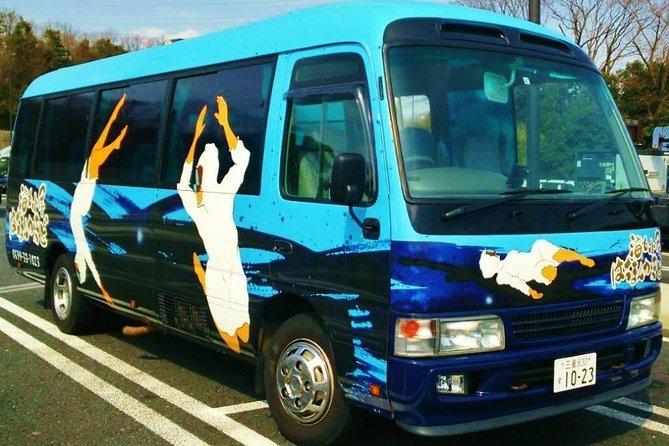
-
Visitors can engage directly with veteran ama divers, including 90-year-old Reiko San, to learn about their physically demanding yet culturally significant lifestyle.
-
The Ama Hut Hachiman in Toba, Japan, offers an authentic cultural exchange, allowing guests to don traditional ama diving costumes and sample nourishing ama-inspired cuisine.
-
Guests can gain insights into the challenges faced by younger ama divers, such as balancing family and careers, and the decline of the practice among younger generations.
-
The Ama Hut Hachiman experience aims to preserve the ama tradition and raise awareness about the hardships faced by these legendary female free divers.
-
The Ama Hut Hachiman is easily accessible, with a shuttle bus available from Kintetsu Railway Toba Station, and accommodates small groups of up to 20 travelers for a personalized interaction.
Exploring the AMA Hut Hachiman
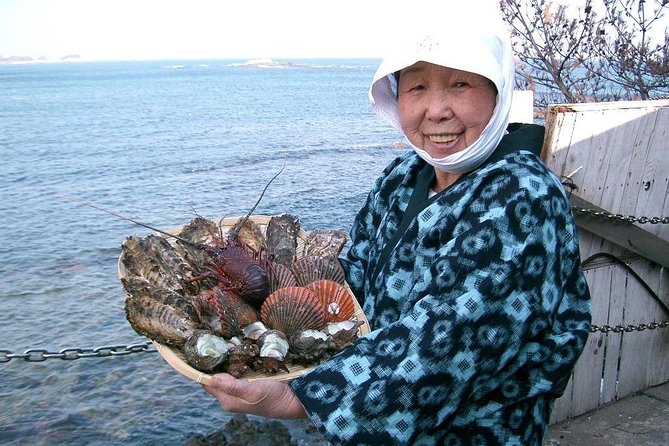
When visitors arrive at the Ama Hut Hachiman in Toba, Japan, they’re greeted by a traditional thatched-roof structure that transports them back in time.
Inside, they’ll interact with real ama divers, the legendary female free divers who’ve plied the waters off the Ise Peninsula for centuries.
Visitors can learn about the ama’s tough, physically demanding way of life and the challenges they face in passing on their traditions.
The intimate setting allows for authentic cultural exchange, where guests can savor fresh seafood, sip local tea, and even don the iconic ama diving costumes.
You can also read our reviews of more tours and experiences in Toba.
Engaging With Veteran AMA Divers
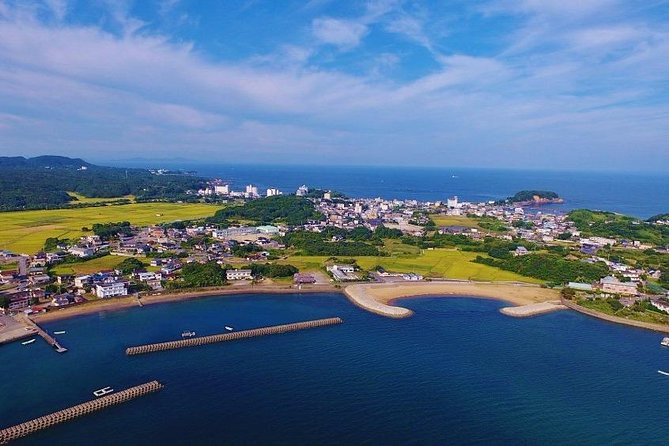
What truly brings the ama culture to life is the opportunity to engage directly with veteran ama divers at the Ama Hut Hachiman.
Visitors are captivated as Reiko San, a 90-year-old ama diver, shares her stories of the tough life of ama divers. She candidly discusses the challenges younger women face in continuing this legacy due to family and job responsibilities.
Guests are immersed in the ama experience through:
- Observing ama divers don their traditional costumes.
- Listening to their first-hand accounts of the ama way of life.
- Gaining cultural insights about the ama community.
- Savoring the delicious baked shellfish and dried fish they harvest.
Discovering the Challenges of the AMA Tradition
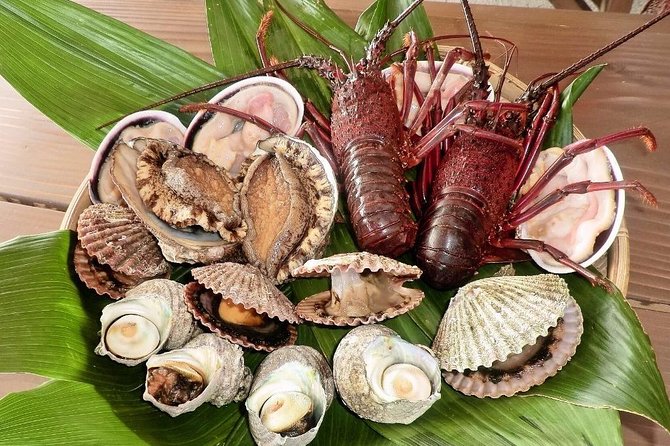
Despite the captivating stories shared by veteran ama divers, the ama tradition faces significant challenges in modern times.
Younger women struggle to balance family responsibilities and careers, making it difficult to commit to the physically demanding profession.
Reiko San, a 90-year-old ama diver, lamented the decline of the practice among younger generations.
With fewer new divers entering the field, the future of the ama legacy remains uncertain.
However, initiatives like the Ama Hut Hachiman experience aim to preserve this cultural tradition by introducing visitors to the ama way of life and the hardships faced by these remarkable women.
Savoring the Authentic AMA Cuisine
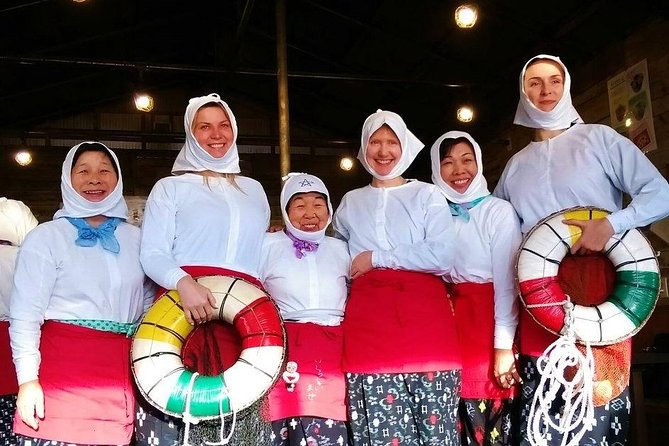
As visitors step into the traditional ama hut, they’re greeted by the tantalizing aromas of freshly baked shellfish and dried fish, the staples of the ama divers’ diet.
The menu features a delightful spread:
- Baked shellfish, a local delicacy plucked straight from the sea.
- Dried fish, a time-honored preservation method that concentrates the flavors.
- Original tea, a refreshing accompaniment to the hearty meal.
- Optional ama costumes, allowing guests to enjoy the cultural experience.
This authentic ama cuisine not only nourishes the body but also provides a glimpse into the resilient lifestyle of these remarkable women.
Taking in the Traditional AMA Culture
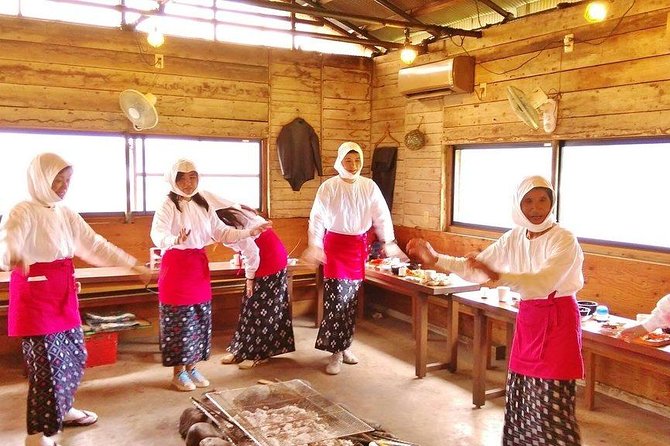
Stepping into the traditional ama hut, visitors are immersed in the captivating world of Japan’s legendary ama divers.
They’re greeted by Reiko San, a 90-year-old diver, who shares tales of the ama’s tough, physically demanding lifestyle.
Visitors learn about the challenges younger women face in continuing this cultural legacy due to family and job responsibilities.
Through Reiko’s stories and demonstrations, the ama’s rich heritage and resilience come alive.
Guests gain profound cultural insights, leaving with a deeper appreciation for this centuries-old profession and the remarkable women who embody it.
Transportation and Meeting Information
Travelers can conveniently reach the meeting point at Ama Hut Hachiman, located at 819 Ōsatsuchō, Toba, Mie 517-0032, Japan.
The shuttle bus departs from the Kintetsu Railway Toba Station, Exit 1 stop. This transportation is wheelchair accessible, accommodates strollers, and provides infant seats.
Key meeting and pickup details:
- Meeting point: Ama Hut Hachiman
- Pickup point: Kintetsu Railway Toba Station, Exit 1 Shuttle bus stop
- Transportation: Wheelchair accessible, stroller accessible, infant seats available
- Maximum group size: 20 travelers
Group Size and Cancellation Policy
The activity has a maximum group size of 20 travelers, ensuring an intimate and personalized experience.
This small group size allows for more one-on-one interactions with the ama divers and a deeper exploration of their unique cultural heritage.
Travelers can also rest assured that their plans won’t be disrupted, as the experience offers free cancellation up to 24 hours prior to the start.
This flexible policy provides peace of mind and the ability to adjust plans if needed.
Highlights From Traveler Reviews
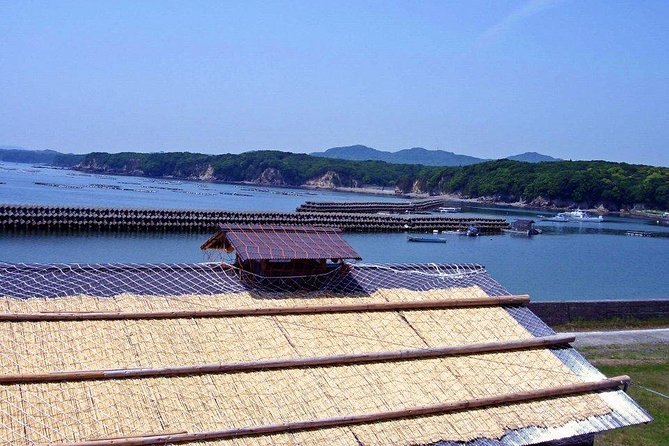
Travelers rave about the unique cultural insights and delicious cuisine they experience during this interaction with real ama divers.
Reviews highlight several standout aspects of the experience:
-
The opportunity to learn directly from 90-year-old ama diver Reiko San, who shares stories of the challenging ama lifestyle.
-
Learning about the difficulties younger women face in continuing the ama legacy due to family and job responsibilities.
-
Savoring the baked shellfish and dried fish, along with the original tea, served in the traditional ama hut.
-
The overall positive feedback on the immersive cultural experience, from the food to the explanations about ama culture.
Frequently Asked Questions
What Types of Souvenirs Are Available to Purchase?
Based on the information provided, there’s no specific mention of souvenirs available to purchase. However, visitors may find traditional ama-inspired handicrafts or local artisanal products on-site that they can take home as mementos of their experience.
Can I Bring My Own Food or Drinks?
No, you can’t bring your own food or drinks. The experience includes a delicious lunch with original tea, so you’ll be well taken care of. Feel free to enjoy the traditional cuisine provided as part of the activity.
Is There a Dress Code for This Experience?
There’s no strict dress code, but wearing lightweight, comfortable clothing that covers your shoulders and knees is recommended. You can also opt to wear the traditional ama costume for an extra fee if you’d like to fully learn about the experience.
Are There Restroom Facilities at the Ama Hut Hachiman?
The Ama Hut Hachiman provides restroom facilities for visitors. Guests can use the clean and well-maintained restrooms during their experience, ensuring a comfortable and convenient visit to learn about the fascinating ama diving culture.
Do the Ama Divers Speak English During the Experience?
The ama divers at the Ama Hut Hachiman speak some English to share their cultural stories and experiences with visitors. However, they may rely on English-speaking guides to facilitate smoother communication during the interactive experience.
The Sum Up
Visiting the AMA Hut Hachiman is a truly immersive experience that allows you to connect with the remarkable ama divers, learn about their demanding profession, and appreciate the rich cultural heritage of this resilient community. From donning traditional costumes to savoring authentic cuisine, every aspect of the visit offers a deeper understanding and respect for the ama’s centuries-old way of life.
